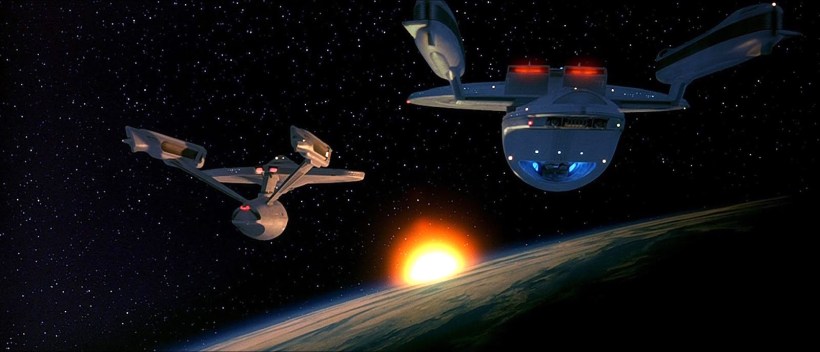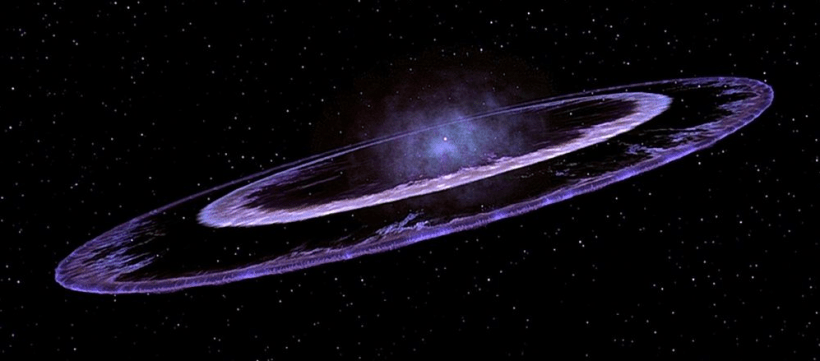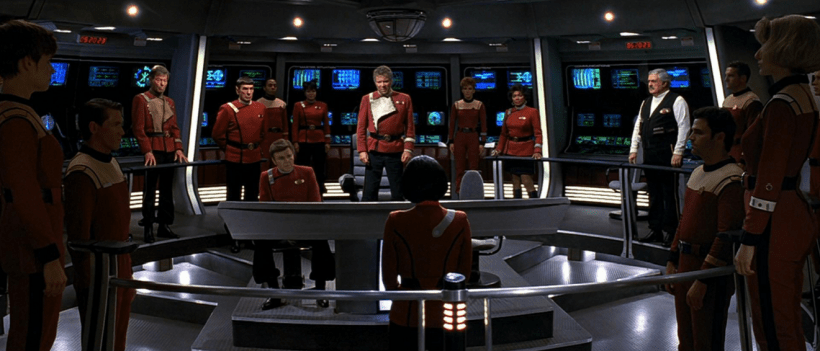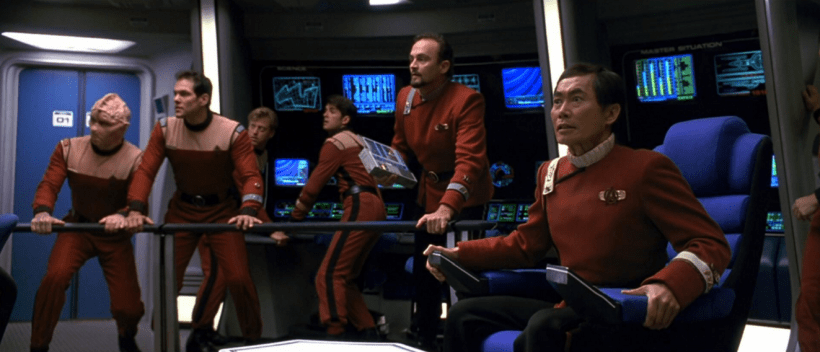Star Trek VI: The Undiscovered Country (1991)
Rated PG
(for sci-fi violence, brief sensuality, and some language)
Released: December 6, 1991
Runtime: 113 minutes
Director: Nicholas Meyer
Starring: William Shatner, Leonard Nimoy, DeForest Kelley, James Doohan, Nichelle Nichols, George Takei, Walter Koenig, Christopher Plummer, Kim Cattrall
Star Trek: Original Cast Movies – A Look Back
Star Trek VI: The Undiscovered Country is a pretty badass movie. Not because of some rock and roll attitude, but rather a Shakespearian one.
Starting off with a literal bang, the final movie of the original cast era does not self-consciously waste time reestablishing its bona fides following the poor reception of Star Trek V. With confidence, it boldly goes from the jump and never lets up. Wielding brains, brawn, wit, and relevance, Star Trek VI – the last adventure for the first crew of the U.S.S. Enterprise – is quintessential Trek in every respect, and even better than I’d remembered.

The Undiscovered Country explodes full force into a Cold War metaphor, with Star Fleet and the Klingons serving as the U.S./Soviet ciphers, with a Chernobyl-styled incident (and global warming-type implications for good measure) that accelerates the likely doom of the Klingon race.
A glasnost is struck between the enemy factions, with Klingon Chancellor Gorkon filling Gorbachev’s shoes (and sporting Lincoln’s beard) while Spock is more Reagan-esque than Kirk, who still clings to hatred over the Klingon murder of his son. (The tension of the guarded, and barbed, dinner conversation between the two sides is brilliantly written and performed.) Then when the action finally kicks in, it does so in rather dramatic (even shocking) fashion.
There’s an inventive adrenaline to this spectacular curtain call, from the onslaught of clever Cold War parallels (both broad and specific) that boasts a thematic and philosophical ambition that wouldn’t even dawn on the reboot of today.
The closest the new Star Trek gets to real-world significance is having a generic terrorist. The original Trek, by contrast, would fictionalize our entire response to terrorism by mirroring the Left/Right ideological divides, how we confront the global scourge (or don’t), and the prickly political implications.
In this case, The Undiscovered Country sought to contemplate what brokering peace between two giant enemy powers would look like, and how that challenge is complicated by bad actors on both sides who want to keep the war going.
Raising the stakes is an ingeniously plotted murder mystery, and then another plot that plays beneath that mystery – one that can’t even be seen until it’s revealed in the film’s second half. In total, it all engages the mind while cranking the suspense, showcasing Spock at the peak of his logical powers (see Trivia below for how Spock links himself as a descendant of Sherlock Holmes).
Plus, Kirk gets to brawl in a few last fistfights and steal one last kiss in playful homage to the swaggering Captain of the initial five-year mission (Shatner is game for self-deprecating jabs at his own ego, too).
Also nifty: not just the fact that Sulu is now Captain of his own Starship, but also how his leadership of the Excelsior is intrinsically woven throughout this narrative (and adds to the film’s aforementioned badass nature).
Director Nicholas Meyer returns for the franchise farewell, bringing the literary depth he infused into The Wrath of Khan – but this time he swaps Melville for The Bard. Just as Khan spat some of Captain Ahab’s most literate jabs, so too does Klingon General Chang revel verbatim in quotes from Hamlet, The Tempest, Henry V, and more. They’re bandied about with delicious conviction by Shakespearian trained screen legend Christopher Plummer.
This sixth and final chapter also restores Star Trek to its rightful place among the elite visual effects blockbusters of the time, after being sorely undercut (along with Shatner’s directorial efforts) in Star Trek V. Right off the top we see that the Star Trek universe has returned to superior sci-fi form, with effects that are as good as (and arguably better than) ever. The opening Praxis effect even set a new industry standard (see Trivia below).
It’s a sweet moment of redemption, too, for producer Ralph Winter who bungled the post-production process on The Final Frontier. As the lead producer here, Winter allows the original cast to bow out with pride over the spectacle they’re in (particularly given the modest $30 million budget he had to work with).
Composer Cliff Eidelman provides a rousing space opera of a score, with textures both nautical and sentimental, that follows in the grand tradition set by Jerry Goldsmith and James Horner.
Star Trek VI: The Undiscovered Country is like the most rewarding TV series finale you could ever hope for, one that plays to our nostalgia (capped by granting the crew a literal standing ovation) without ever coasting on it, instead giving us as vital and ambitious an original story as the franchise has seen, and that stands alongside its best. Then as the final credits begin to roll, Star Trek VI becomes a literal love letter signed to the fans.
Wrapped up with high drama, deep sentiment, and pure class, Star Trek VI: The Undiscovered Country is so good and so satisfying that it leaves you wanting more – which is exactly how a saga of this stature should end.
Available to rent through Amazon Instant Video. (Currently free to stream for Amazon Prime members.)
NOTABLE TRIVIA
- The subtitle The Undiscovered Country – which is derived from Hamlet’s “To be or not to be” soliloquy – was originally considered for Star Trek II before that was finally labeled The Wrath of Khan. Both movies were directed by Nicholas Meyer.
- During the story’s mystery, Spock tells the crew, “An ancestor of mine maintained that if you eliminate the impossible, whatever remains – however improbable – must be the solution.” The “ancestor” that Spock quotes is actually Sherlock Holmes. Writer/Director Nicholas Meyer was a Sherlock aficionado, and his novel “The Seven Percent Solution” is considered by many to be the best non-Sir Arthur Conan Doyle Sherlock story ever written.
- The visual effect for the explosion of the Klingon moon Praxis became a popular one repeated for other similar explosions, including in the 1997 special edition versions of Star Wars and Return of the Jedi. It was called “The Praxis Effect”.

- The role of Vulcan Lt. Valeris (played by Sex and the City’s Kim Cattrall) was originally written as Lt. Saavik from films II, III, and IV. But Gene Roddenberry objected to that interpretation and arc for Saavik, so it was changed to an original new character.
- The Klingon lawyer Worf seen here played by Michael Dorn is Colonel Worf, not Lieutenant Worf of The Next Generation. The Colonel is the grandfather of the Lieutenant.

- In his brief cameo scene, Christian Slater wears the uniform trousers that William Shatner wore in Star Trek II: The Wrath of Khan.
- The Al Pacino/Michelle Pfieffer movie Frankie & Johnny was being filmed at the same studio. For a scene in which Pacino has to act surprised after opening a door, director Garry Marshall had Shatner and Nimoy dressed up as Kirk and Spock on the other side of that door.
- The year this takes place is 2293, established by McCoy’s comment that he had served on the Enterprise for 27 years. This means that the events of Star Trek VI occur six years after the events of Star Trek V (although the films are only two years apart) and twenty-two years after the events of Star Trek: The Motion Picture (but only twelve years between those films). Given the degree to which most of the aged, the Trek timeline looks more authentic than the real one.
- Producer Harve Bennett was passionate about making a Star Trek prequel movie next, set in their academy days, which would re-cast the roles with younger actors. He even had a script written by Star Trek V writer David Loughery and was openly considering Ethan Hawke and John Cusack for the roles of Kirk and Spock. Fans, the studio, and Gene Roddenberry all objected. Bennett was so disappointed he left the series. Executive Producer Ralph Winter was promoted to lead Producer.
- David Warner, who plays Klingon Chancellor Gorkon, also played a Starfleet ambassador in Star Trek V.

- Jack Palance was originally offered the role of Gorkon, but he had to pass because the shoot dates conflicted with his work for City Slickers, the movie that would garner him an Academy Award for Best Supporting Actor.
- Both Warner and Christopher Plummer gave notable stage performances of Hamlet in the 1950s and 60s, and Shatner was a Plummer understudy early on in his career for several Canadian Shakespeare productions.
- This was the first time that the “T” of James T. Kirk was ever stated as “Tiberius” on-screen, despite having been well known with fan culture. It’s also the first time that Sulu’s first name Hikaru is spoken. Uhura is the only character to never have had her first name spoken throughout the entire television or film series. It’s Nyota, and it was final spoken in the 2009 reboot.
- Director Nicholas Meyer originally asked composer James Horner to return to the franchise, and then Jerry Goldsmith, but both refused. He eventually hired Cliff Eidelman because Meyer felt his demo submissions had the perfect mix of Gustav Holst’s “The Planets” grandeur and the styles of Horner and Goldsmith.
- Many of the Enterprise sets were redresses of Enterprise D sets from The Next Generation, which was still being produced at the time.
- This was the last screen appearance for DeForest Kelley as Dr. McCoy. It was also the final canonical appearance for Nichelle Nichols as Lt. Uhura, although she reprised the role in the 2004 fan fiction series Star Trek New Voyages: Phase II.
- In his capacity as Executive Producer, an ailing Gene Roddenberry viewed the first rough cut of the film to give notes. Less than 48 hours after that screening, he passed away.








I happened to watch this with my kids today. There are some plot holes that have always bugged me — and they definitely still do today — but the film has its moments, for sure.
And it’s striking to see how consistently the film undermines “human” assumptions and “human” privilege, from the Klingon woman’s statement that terms like “inalienable human rights” are fundamentally “racist” to Spock’s statement that it is “insulting” to say everyone is human to the revelation that various aliens have different-shaped feet, differently-placed genitals and differently-coloured blood, etc.
As for trivia, I must note that this is quite possibly the most Canadian Star Trek film of them all. In addition to series regulars William Shatner and James Doohan (born in Montreal and Vancouver, respectively), it features guest stars Christopher Plummer (born in Toronto) and Kim Cattrall (grew up on Vancouver Island). Shatner and Plummer also have a personal history going back to the 1950s, when Shatner understudied Plummer in a Canadian production of Henry V; there’s a featurette about this on the ST6 DVD.
LikeLiked by 1 person
Yeah, I made reference to Plummer and Shatner’s past Canadian theatrical collaboration in my trivia section, but didn’t realize the Canadian contingent of the cast was that extensive.
As far as undermining “human” assumptions, apparently Roddenberry’s final notes before he passed suggested that the movie didn’t take far enough. Specifically, he was upset by how he felt the Klingon’s were portrayed as one-dimenionsal villains (I disagree) because we never got to see any of their own culture. He felt it was a major fault of the cut he saw.
LikeLike